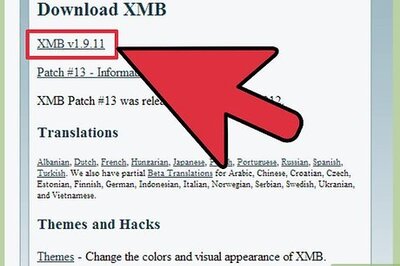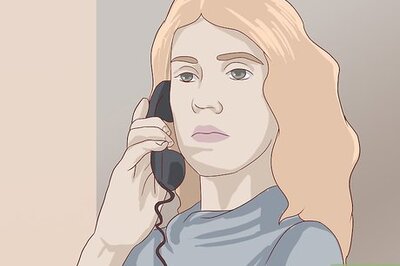
views

Study your photo reference carefully and decide where you want your leopard to be on the page. Draw a little thumbnail sketch for the composition. You don't have to draw the animal perfectly for the thumbnail, if it's only an inch high and as wide proportionally as the paper for your final drawing you're just placing the cat and deciding how large it is in relation to the drawing. You'll surprise yourself at how easy it is to sketch the animal's overall shape that tiny though - it's an abstract shape, a squiggle that may have legs, ears and tail sticking out. Try several different compositions and use the one you like best. This is important practice for paying attention to the proportions too - your little thumbnails each make you understand the length of the body to height ratio and the curves of its pose.

Make some light tick marks on the actual page scaling up the placement you figured out in your composition thumbnail. Put a mark at the highest part of the leopard, a mark where the tail meets the body and another at the end of the tail, one where the edge is closest to the right, marks for where any protrusions like feet go and where the belly is. These marks are guides for proportion that will make your leopard look realistic. You can print out your reference photo and work out these proportions mathematically too. An easy way to do "twice as large" is to just use half inches for the units on the photo and full inches on your paper, for example. Try for an easy proportion that fits your page. Maybe 3/8" to one inch will do it, or 3/4" to one inch. Using a grid ruler is great because it gives you proportions in both directions at once.

Block in the cat. Start by drawing two overlapping egg shapes for the body. A cat's back bends sharply in the middle, if it's crouching or arching its back that bend is easy to see. It might be subtle but this will give a better proportion for a cat's long body even if you don't see that bend in that pose. Pay attention to the pose in your photo reference. If the leopard's at an angle facing you, the full length of the body may not show and the oval may be more like a cross section or mostly chest. Add shapes for the neck, legs, and head. Draw a curled tail line, and then move to the next step. With the tick marks in place, you will get these block-in shapes the right size in the right relation to each other. If a shape looks more rectangular than oval, sketch it like it is rather than insisting they all have to be ovals.

Look at the photo for where the features are placed. You may want to use tick marks again to place the eyes and nose. A common problem in cat faces is that if the cat's head is at a slight angle, you can get the nose twisted funny by drawing it straight up and down with the page rather than at the same angle as the eyes. So doing tick marks for placing all three are good, then your cat's head angle will stay consistent! You will now start sketching out the shape of the face starting with the snout and lip. Then draw the bridge of the nose and shape of the eye.

Start sketching out the shape of the leopard's head until it is all drawn out. Once that is done you can add the chin, whiskers, and then the small ear shapes. The body of this animal is very hearty so don't skimp on width when it comes to sketching out the thick neck and chest.

Draw the lining for the cat's back lightly. Next sketch out the thick, fury tail. Every part of this animal has boldness and girth, so you must express that through your drawing. Add the solid spots, leopards are fluffy, so a hard line isn't as good to follow their back, break it a few times with light and then proceed on. Look at the photo to see whether the leopard's fur lays smooth or is fluffy - snow-sketchy lines in the direction of the fur.

Sketch out the belly of this animal and then draw out the legs and large paws. The belly should be hairy looking, belly hairs are fluffy so don't sketch this with a smooth hard line. Use short light strokes that follow the direction of the hairs and suggest hairs. Don't try to draw every hair. The hind legs should look large and meaty.

Shade the leopard to show the modeling shadows on its body. Do this softly by smudging with a bit of soft graphite on your finger or a tortillon. Follow your photo reference for the shapes of body shadows. Ignore the spots and just see which areas are shiny highlights or light gold and which shadowed areas seem more of a dark gold or brown. This will make your cat look three dimensional and he may look a lot like a puma at this stage. Add a few light fur texturing strokes within the shadows to imply that the light areas are fluffy too.

Complete the drawing. The last step is the tricky bit. You need to do is sketch out each spot that is on the leopard's body. Since no one leopard is the same, you can pick and choose where you want your spots to be. You may want to erase some of the guidelines and shapes that you drew in earlier, but this isn't necessary - sometimes leaving guidelines in can make a drawing look cool. It's not a photo, it's a drawing, right? That's a style choice. Look closely at the way the spots lay on different parts of the body. They may look rounded or stretch to narrow ovals by the angle of the skin. Getting the shapes right for what part of the body they're on is a major step in realism. Don't draw every spot. You are doing a leopard that's maybe a few inches long but the real cat is as large as you are - fewer spots in more or less the right relationship to the size of the animal are more effective at giving the impression it has a lot of spots. When they are distorted by perspective and flattened along the top of the back or wrapped around the tail, they help to describe three dimensional form as much as the shading does.

Practice drawing leopards in different poses until you're comfortable with the leopard's anatomy. They don't all need to be finished drawings with every spot detailed - sometimes just a few to indicate it's a leopard becomes enough in a working sketch. Keep this up and you may become a famous wildlife artist someday!

Practice drawing leopards from life on zoo visits. Don't expect good finished drawings unless the cat sleeps for half an hour. Animals move. Life drawings can be left unfinished, start over if the leopard changes its pose. Try for poses the cat takes repeatedly while pacing back and forth or looking back at the crowd. Do a little, work on a different one, go back when it takes the pose again. You will learn a lot from life drawing even if your drawings from photos look more polished. Eventually these quick sketches can become references for lively poses you can't find in a source photo.




















Comments
0 comment